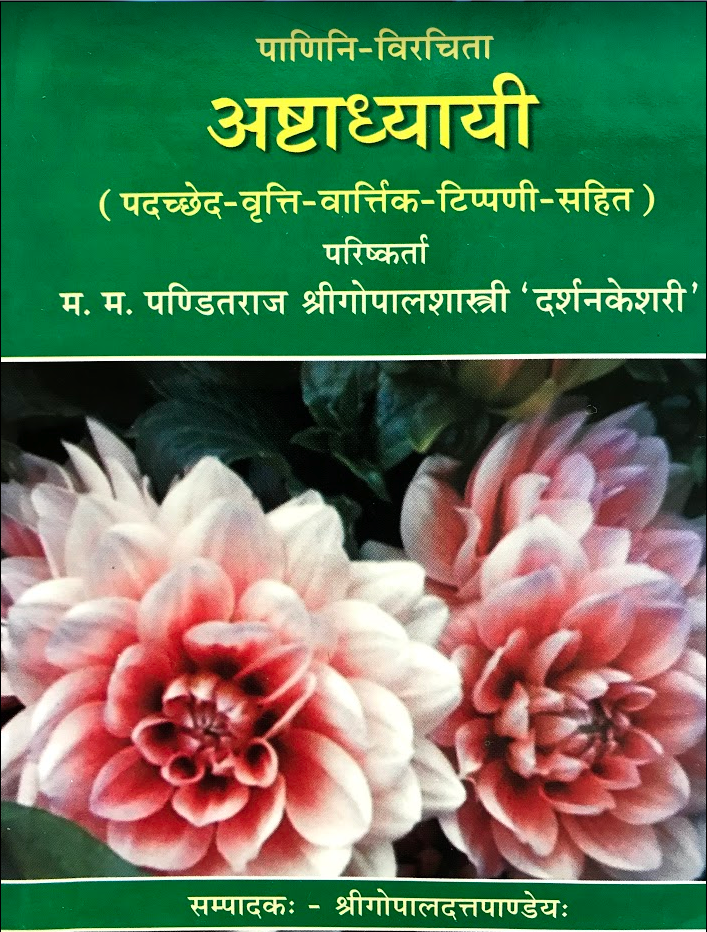(This article requires basic understanding of Samskritam grammar)

When it comes to Samskritam grammar, the definitive books are Panini’s Ashtadhyayi and Dhatupaatah. Then why do we have so many other books like vartikas, bhashyas and kaumudis. What gap do they address? Specifically, what does a book like Siddhanta Kaumudi adress? To understand that we need to start with the basics and go down in a systematic way.
Let’s start with a simple sentence
गृहतः कार्यालयं गच्छति
When you see this sentence and have no clue about Sanskrit, you will know that, this sentence is made up of three words.

It can split once again by separating the प्रकृति: and प्रत्यय as follows. In each section, the first word is the प्रकृति: and the second, the प्रत्यय

Can this be split even further, like how we can split NaCl into Sodium and Chlorine and then into atoms and other sub-atomic particles? How far can we split the words in Samskritam and what is the end beyond which we cannot split further? In Samskritam, that root is called a धातु. There are approximately around 2000 धातु and 480 प्रत्यय. All the known words are formed by a combination of these.
Samskritam grammar is essentially a reverse engineering of the rules of the spoken language. The language came first and then the grammar. If you are a grammarian, and want to construct the rules of the language, there are two ways of doing it.
- List the rule for each word. This obviously does not scale. The real world example would like calling the name of each student in the school and asking them to come into the class.
- Come up with generalized rules which apply to a broad category. Come up with exceptions to those rules. The general rule could be, everyone enter the class and the exception could be – except Rahul. This makes the encoding of the rules simpler and easier to remember.
Samskritam grammar is essentially a reverse engineering of the rules of the spoken language. The language came first and then the grammar. If you are a grammarian, and want to construct the rules of the language, there are two ways of doing it.
- List the rule for each word. This obviously does not scale. The real world example would like calling the name of each student in the school and asking them to come into the class.
- Come up with generalized rules which apply to a broad category. Come up with exceptions to those rules. The general rule could be, everyone enter the class and the exception could be – except Rahul. This makes the encoding of the rules simpler and easier to remember.
Panini demonstrated that with just less than 4000 sutras, he could come up with all the rules for all the words in Samskritam. This was possible only because the approach he took was the second one.
Panini’s two books cover this
- Dhatupatah – covers all the dhatu and their meaning
- Ashtadhyayi – covers all the प्रत्यय, (Chapters 3, 4, and 5)
The Ashtadhyayi consists of 8 chapters and they cover the following topics
- 1, 2 – संज्ञा, परिभाषा, समासः, कारकं
- 3,4,5 – प्रत्ययाः
- 6, 7, 8 – संधिः, प्रत्ययानां योजनम्

Among the Sanskrit grammarians, the most famous are Panini, Katyayana and Patanjali. Katyayana wrote vartikas (explanatory texts) and Patanjali wrote mahabhashyam (great commentary). The books they wrote are succinct and does not contain examples of the rules. This makes it hard for a student who try to study the grammar.
Then came a second set of books called व्रित्तिग्रन्धा: These books have more details about the sutra, like how to split it, the meaning of these words, examples, clarification of doubts, etc. Among these the famous are काशिकवृत्तिः and प्रथमावृत्तिः These texts follow the same order as the sutras in Ashtadhyayi.
This becomes a problem if you are interested in one topic like समासः. The sutras for these are not together and hence a student following the original texts or the व्रित्तिग्रन्धा: will have to collate the related sutras and figure it out.
To address this issues, there came a type of text called the प्रक्रियाग्रन्धा: These are organized according to topics with everything related to संधिः in one place and everything related to समासः in one place. Famous in this category are रूपावतारः, प्रक्रियाकौमुदि. But these books had some issues and caused confusion. Then Bhattoji Dikshit wrote सिद्धान्तकौमुदि fixing all the issues among the previous books. He explained all the sutras, in the style of प्रक्रियाग्रन्धा:and corrected the issues with the previous books.
(Based on the lecture by Tilak Rao. If you are interested in learning Siddhanta Kaumudi, here is the playlist)
